Theater and IT: Shakespeare never dreamed of
It is customary to read about the penetration of information technologies into production, finance, logistics, retail and other areas. And what if you combine theater and IT?
I was lucky to participate in such a project and follow not the usual TK, but the director's idea, which was finally formed before my eyes. In the Moscow Drama Theater named after M. N. Yermolova, we installed audiovisual equipment, and for a couple of months I was a full participant in rehearsals - I followed the process from behind the scenes and from the balcony where the workplace of the video editing engineer was located, set up the equipment and made adjustments.

')
I will tell you about our experiments in the field of theatrical art, about difficulties and victories. In this post there will also be a lot of photos: the theater is in fact entertaining art. And for the most impatient right under the cut I spread the video spoiler. In this video there are no technical details (unlike the post), but in just three minutes you will learn about joint projects between LANIT and the Yermolovsky Theater.

In the theater Yermolova brought us the case. A small project for the supply of office equipment for the administration introduced the head of LANIT and artistic director of the theater Oleg Menshikov. And, as they say, everything began to turn out. It became clear that we have no other way, except to the Yermolovsky Theater.
So LANIT became the technological partner of the theater. But information technology did not reach the scene immediately. First, in the theatrical showcase on Tverskaya, we installed a video pane for online broadcasts of performances and rehearsals, demonstrations of commercials, and posters. The experience of using the video broadcasting system turned out to be successful, and video panels appeared in all four windows of the facade.

The screens in the windows of the theater, and even two steps from the Kremlin, it is impossible not to notice. Naturally, passersby pay attention to them, stop, come to the theater. The administration noted that video pane affected both ticket sales and attendance.
And then - on the rise: joint IT projects became more and more creative and technically complex.
Digital solutions on the stage of the theater first appeared in the play “Portrait of Dorian Gray,” staged in 2013 by director Alexander Sozonov.

In the performance we used several types of projectors (the full list of equipment is given below under the cut), a projection screen and a billboard. One of the projectors illuminates the background of the scene, where the pictures necessary for the meaning of the play unfold.
An important place on the stage was allotted to a large 3.5 × 2 m pendant screen: it became either a mirror or a picture. This screen, together with a short-focus projector, moves around the portal of the scene, quickly changing the scenery and solving creative tasks during the performance. All structural fasteners, mechanics and drives had to be made to order.
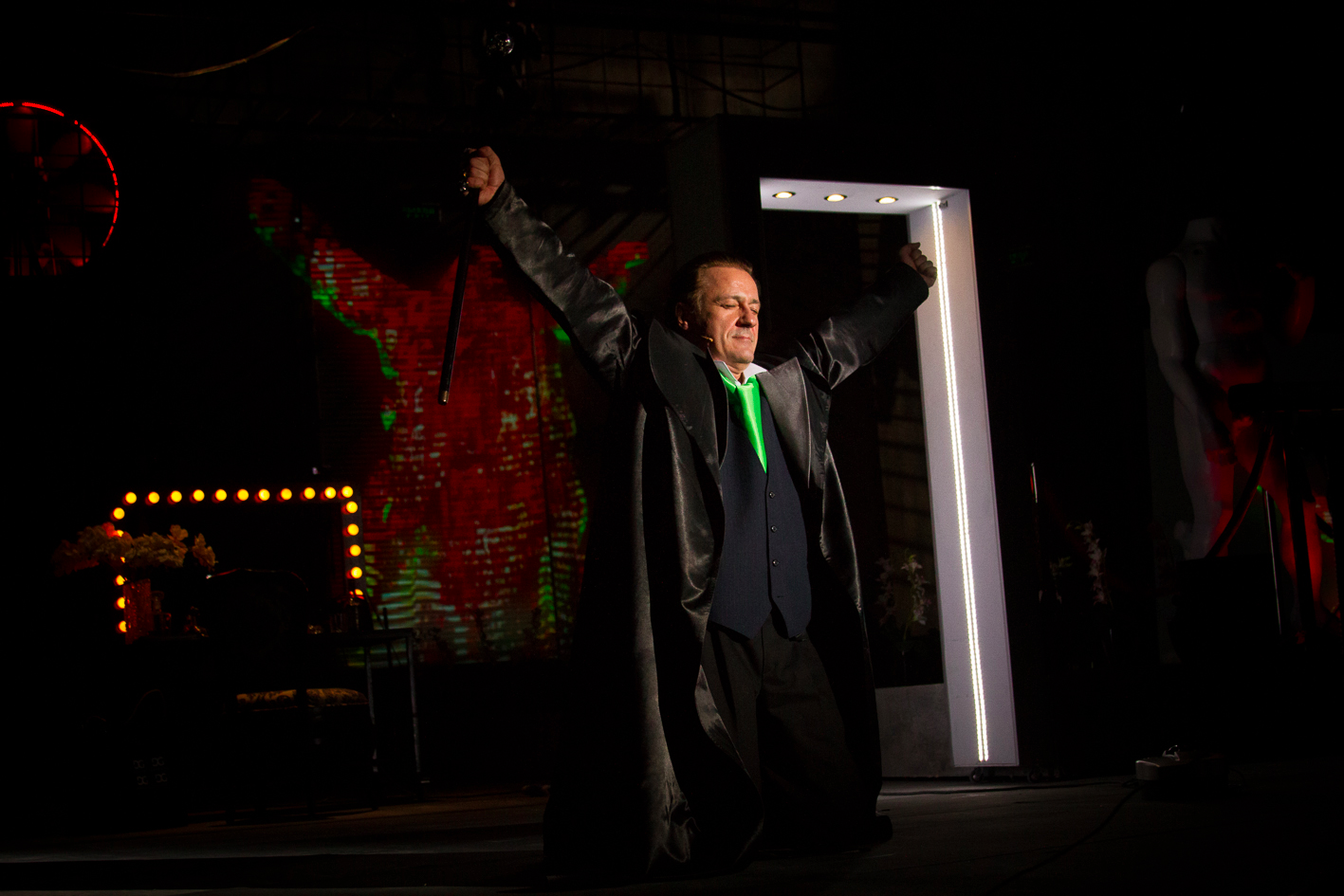
Why was all this necessary? After all, there are a huge number of performances that do without any panels.
Dorian Gray was supposed to appear before the viewer not as a real character, but as the fruit of Lord Henry's production work - a kind of modern myth, an image of eternal beauty with which you can achieve unlimited power. The portrait of Dorian Gray, whose hero was played by Sergei Kempo, as conceived by the director, is distorted in front of the viewer, decomposing under the influence of his own vices. To show this to the viewer, video installations and special effects were required.
At that time, the theater had no production experience for creating a multimedia production: neither the director, nor the theater engineers, nor even the artists, knew how to implement all this. Then Ermolovtsy and turned to us for help.
The team worked on the visual concept of the production, which, in addition to the director, theater video engineers, and invited video artists, included specialists from our IT company. We discussed the entire video series of the performance: the director said what effect should be achieved from the technique, and we offered options for how to do it.

I and two other LANIT-Integration specialists participated in production meetings of the staging group. Content and graphics were finalized right during the rehearsals: the director was looking for the perfect composition between the position of the equipment, the actors on the stage and the broadcast content.
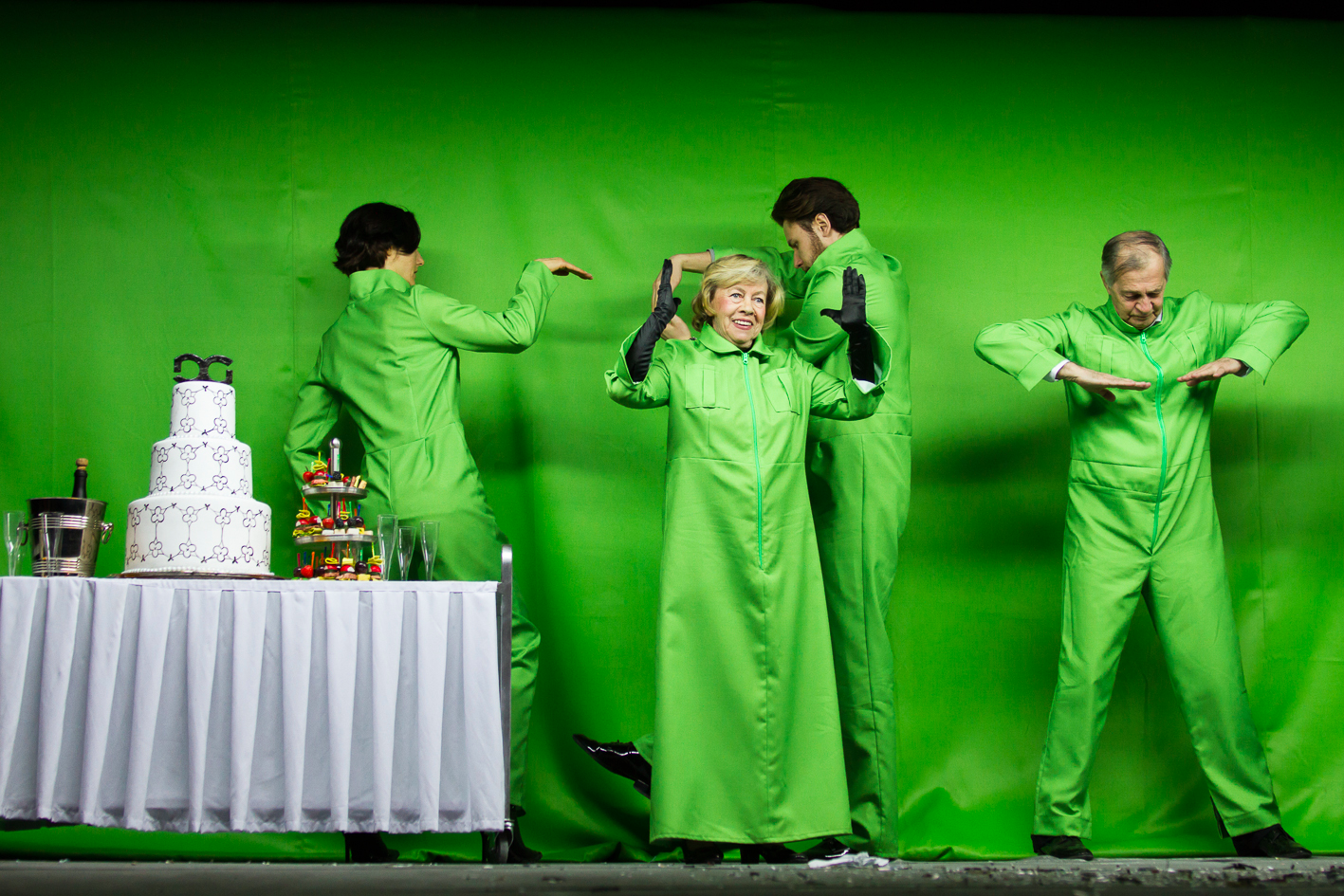
Modern technology we had to build into the stage space of one of the oldest Moscow mansions. In addition, the equipment should not interfere with the actors. Therefore, we used wireless signal transmitters, maximally reducing the distance between them. And for a building in the center of Moscow, in the immediate vicinity of two international hotels, in which the security services of high-ranking guests constantly drown out the signal, this is a serious problem.
As a result, we took the cable and optical receivers-transmitters, moved them from the equipment to the stage's tablet, fixed it on the soffits. As a result, the distance from the wireless receiver-transmitter to the wireless camera with which the actor walks on stage has decreased, and the signal is transmitted to the space of the stage, and not to the hall.

At first, there were emergency cases. Naturally, we could not foresee all possible emergency situations, if only because the building of the theater is old and it was not always clear how this or that equipment will behave in it.
Before the premiere of "The Portrait of Dorian Gray," electricity surges began, and the connection between the reception and transmission of video began to break. Then from the office I had to urgently bring an uninterruptible power supply generator. Fortunately, we managed to connect it before the start of the performance. Everything turned out, the premiere was sold out, but this case was a big shake-up for all of us. Now, of course, all technologies are already well "run-in", and nothing like this can happen.

Our “pilot” performance showed that the theater needs a separate service to create video content and work with video equipment. So a new department appeared - a video workshop. At first, we actively consulted his employees, but now there is no such need.
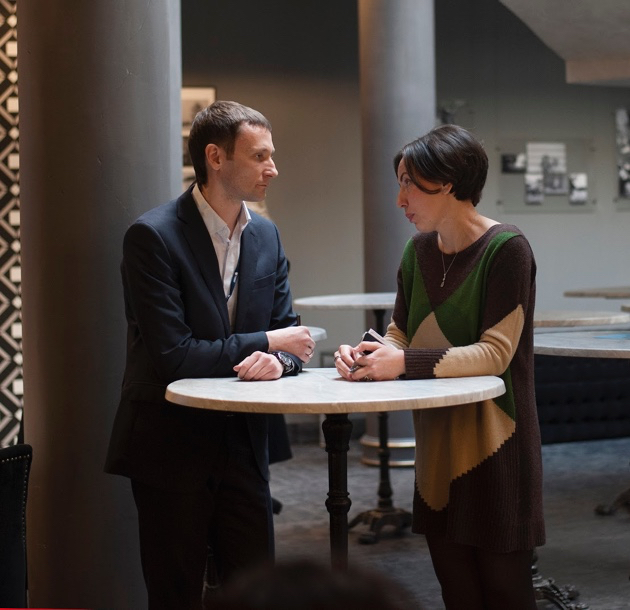 I am with Elena Marchenko, who now heads the theater's video workshop.
I am with Elena Marchenko, who now heads the theater's video workshop.
In the play "Portrait of Dorian Gray" there are three video components.
First is life. On the billboard are displayed from the camera those parts of the scene that are usually not visible to the viewer, or close-ups that are important for semantic accents.

Secondly, this is the chroma key - a technology that allows you to photograph a person on a green background and embed the hero's image in any video sequence. During the performance, the image of the actors from the cameras in real-time mode is combined with the backgrounds and video sequences prepared by the theater's video artists and projected onto the canvas behind the stage.

Thirdly, it is kinect. Body movement recognition technology turns Dorian Gray’s silhouette into a decaying portrait.
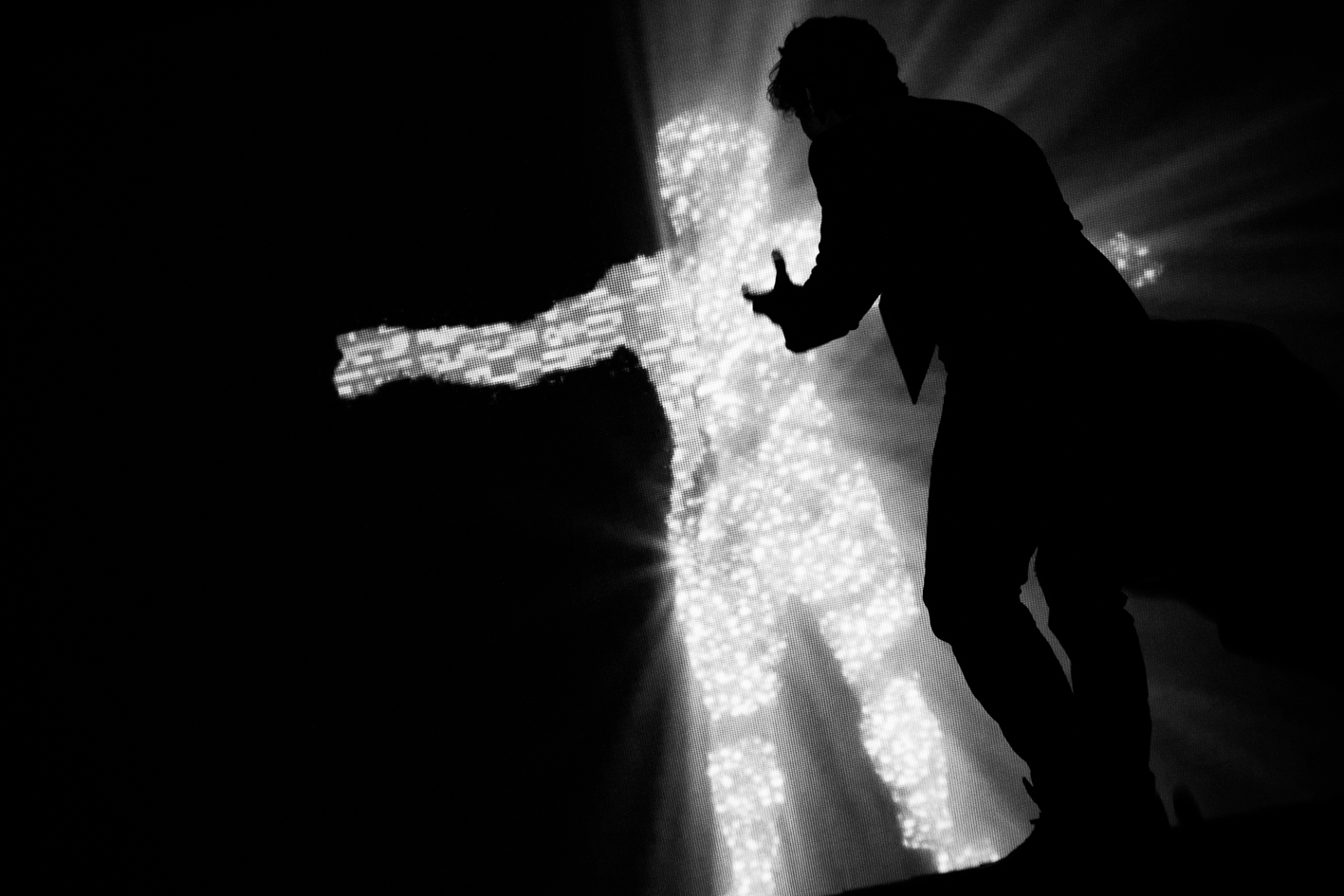
Information technologies on the stage expand the space and help create new meanings.
Interestingly, the actors themselves while working do not immerse themselves in virtual reality, because they do not see what appears before the eyes of the public. From behind the scenes, the backdrop is usually visible, in which, for example, “Left / right side of the tower” is written in black paint. From here actors and go on stage. Therefore, it is useless to ask them how all these cameras, projectors, and screens influenced them.
The second performance using IT on the big stage was “Lucky Men” staged by Oleg Menshikov. This is a story from the future: by 2080, mankind has found a unique way of changing generations - the fate of the elderly is decided by the State Commission for the Optimization of the Population. People over the age of 80 must pass a test that resembles the well-known IQ test. The results are announced on the popular TV show "Lucky". For winners, the reward is life. And the losers are escorted to the other world with honors.
All audiovisual equipment costs a lot of money, and not every metropolitan theater can afford experiments like ours. Oleg Menshikov said that the cost of only one projector involved in the play "Lucky", is comparable to the budget of the entire performance.
Therefore, anticipating the question of the conditions of cooperation between LANIT and the theater, I will immediately say that all the equipment was donated to the Ermolovtsy, and the head of the group of companies calls this step as patronage. It is about the transfer of several dozen positions of expensive modern equipment to the theater, including multimedia projectors, cameras, monitors, video editing equipment, laptops, computers, printers, etc.
For the play Lucky People, LANIT donated a Panasonic PT-RZ12KE laser projector with an ET-D75LE20 lens to the theater, with a minimum noise level, which is important when installing a projector in the auditorium.

In the fall of 2014, the theater solemnly opened the New Stage, which we also equipped with modern video equipment. A chic spiral staircase with wrought iron railings rises to the auditorium, designer interiors in the hall.
All this is done with taste and is designed for the discerning public. And we took upon ourselves the task of equipping the auditorium on the second floor of the same old mansion and when designing to take into account the peculiarities of its structures and communications.

There is a niche in the wall behind the stage, which we used in the projection Adam and Eve / Shaping for video projections. Video projections are modern decorations - behind the characters, director Olesya Nevmerzhitskaya “drew” clear geometric boundaries that help to build the necessary mise-en-scenes and at the same time are a good lighting solution for the production.

The play “Adam and Eve” is in principle impossible to imagine without special technical equipment, because this is a story that takes place in our time and raises the question about the possibilities and limits of modern art: what does freedom of expression mean for a modern artist, can people be used to create their art objects?
The technical equipment in the performance is not a service element, but a key semantic artistic solution of the performance.

The video pane used in the performance demonstrates to the viewer the feelings and thoughts of the characters. On this stylized smartphone screen, you can read the characters' correspondence, comments, and see likes.
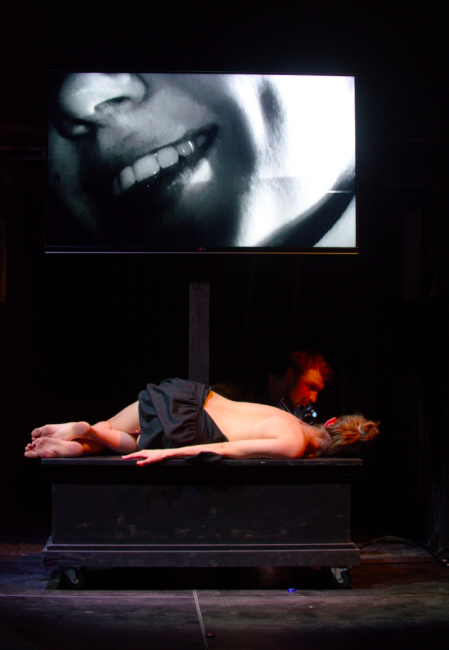
In the foyer of the New Stage, we installed the gesture recognition system Viziware, developed by another LANIT subsidiary - LANIT-Terkom . Thanks to video cameras capable of calculating distances to objects and working like a human eye, the system allows you to control the screen and enter data using simple gestures. The system in real time monitors objects in front of the screen, assesses their position and speed. Unique algorithms process the received information and "read" the user's gestures. The device then executes the command given by the gesture.
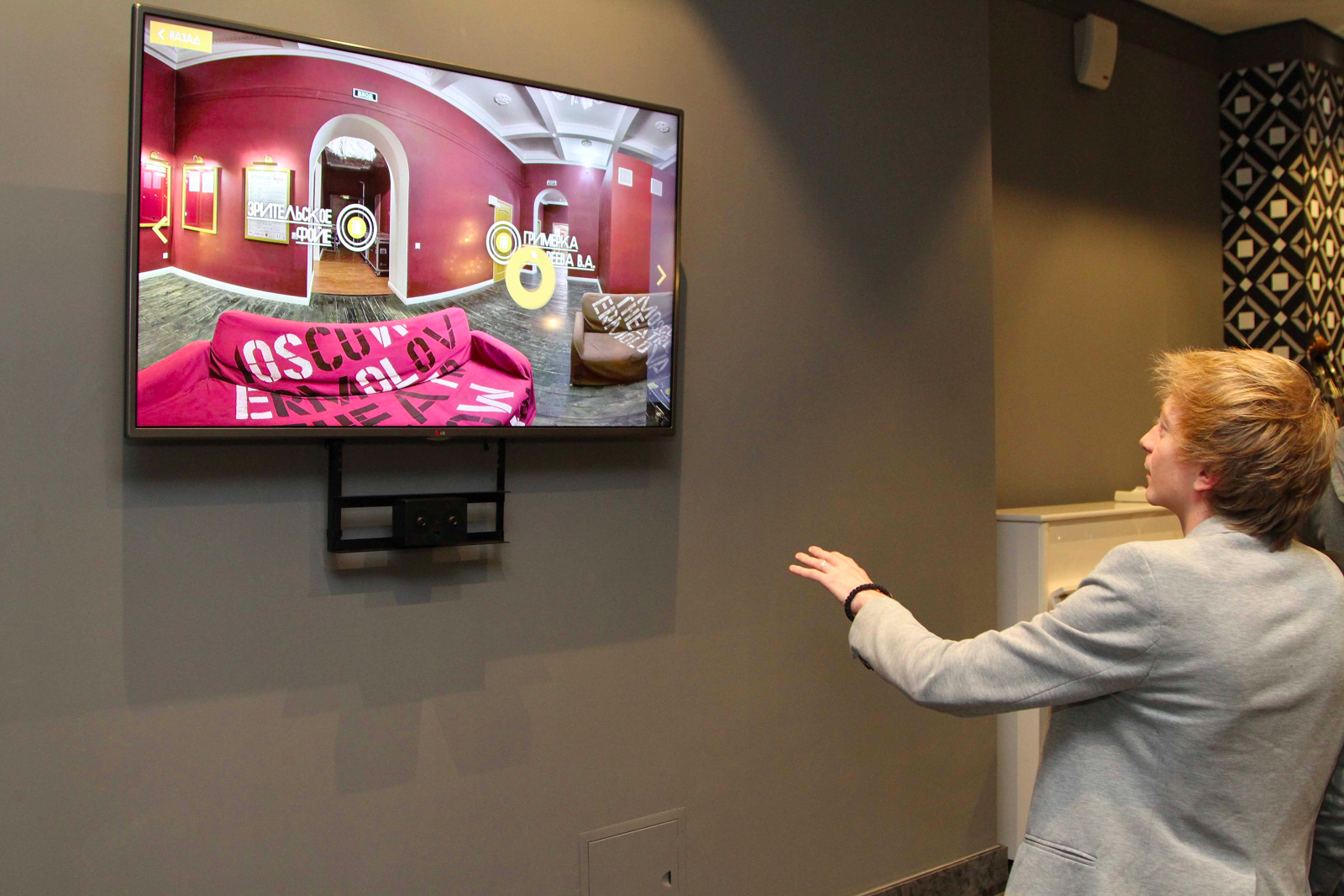
With the help of Viziware, viewers can view the poster of the theater, information about the troupe and the current repertoire, take a trip to the backstage of the theater’s main stage — visit the make-up rooms, Oleg Menshikov’s office, look into the scene pocket with the scenery of the performances. You can also imagine yourself a director and collect your orchestra from different instruments.
For the management of the theater, Viziware is an additional marketing tool: firstly, the viewer perceives any information placed in a game form more quickly and with great pleasure, and secondly, the system collects and processes complete statistics about the visitors of the interactive "shop-window".

Continuing cooperation with the theater, LANIT retrofitted the New Stage with multimedia equipment, which made it possible to hold film screenings here. In 2016, the theater showed documentaries of the festival "Docker" and modern author's non-fiction cinema as part of the program "Yermolovsky + cinema". This has become a new form of dialogue between the theater and the audience.
What do you think about the tandem of theater and IT? Perhaps you have already been to performances with high-tech means of expression? I will be glad to your opinion.
By the way, for those who want to become part of our team, there is a vacancy in LANIT-Integration: “System Architect (IT Infrastructure) ”.
I was lucky to participate in such a project and follow not the usual TK, but the director's idea, which was finally formed before my eyes. In the Moscow Drama Theater named after M. N. Yermolova, we installed audiovisual equipment, and for a couple of months I was a full participant in rehearsals - I followed the process from behind the scenes and from the balcony where the workplace of the video editing engineer was located, set up the equipment and made adjustments.
')
I will tell you about our experiments in the field of theatrical art, about difficulties and victories. In this post there will also be a lot of photos: the theater is in fact entertaining art. And for the most impatient right under the cut I spread the video spoiler. In this video there are no technical details (unlike the post), but in just three minutes you will learn about joint projects between LANIT and the Yermolovsky Theater.
How do we even come to this
In the theater Yermolova brought us the case. A small project for the supply of office equipment for the administration introduced the head of LANIT and artistic director of the theater Oleg Menshikov. And, as they say, everything began to turn out. It became clear that we have no other way, except to the Yermolovsky Theater.
So LANIT became the technological partner of the theater. But information technology did not reach the scene immediately. First, in the theatrical showcase on Tverskaya, we installed a video pane for online broadcasts of performances and rehearsals, demonstrations of commercials, and posters. The experience of using the video broadcasting system turned out to be successful, and video panels appeared in all four windows of the facade.
The screens in the windows of the theater, and even two steps from the Kremlin, it is impossible not to notice. Naturally, passersby pay attention to them, stop, come to the theater. The administration noted that video pane affected both ticket sales and attendance.
And then - on the rise: joint IT projects became more and more creative and technically complex.
How to create a modern media image on stage?
Digital solutions on the stage of the theater first appeared in the play “Portrait of Dorian Gray,” staged in 2013 by director Alexander Sozonov.
In the performance we used several types of projectors (the full list of equipment is given below under the cut), a projection screen and a billboard. One of the projectors illuminates the background of the scene, where the pictures necessary for the meaning of the play unfold.
An important place on the stage was allotted to a large 3.5 × 2 m pendant screen: it became either a mirror or a picture. This screen, together with a short-focus projector, moves around the portal of the scene, quickly changing the scenery and solving creative tasks during the performance. All structural fasteners, mechanics and drives had to be made to order.
Why was all this necessary? After all, there are a huge number of performances that do without any panels.
Dorian Gray was supposed to appear before the viewer not as a real character, but as the fruit of Lord Henry's production work - a kind of modern myth, an image of eternal beauty with which you can achieve unlimited power. The portrait of Dorian Gray, whose hero was played by Sergei Kempo, as conceived by the director, is distorted in front of the viewer, decomposing under the influence of his own vices. To show this to the viewer, video installations and special effects were required.
If there is an opportunity for the director to use additional tools, why not use them? That is how Oleg Menshikov subsequently explained his own decision to give space to IT experiments in his theater.
At that time, the theater had no production experience for creating a multimedia production: neither the director, nor the theater engineers, nor even the artists, knew how to implement all this. Then Ermolovtsy and turned to us for help.
The team worked on the visual concept of the production, which, in addition to the director, theater video engineers, and invited video artists, included specialists from our IT company. We discussed the entire video series of the performance: the director said what effect should be achieved from the technique, and we offered options for how to do it.
I and two other LANIT-Integration specialists participated in production meetings of the staging group. Content and graphics were finalized right during the rehearsals: the director was looking for the perfect composition between the position of the equipment, the actors on the stage and the broadcast content.
Equipment for the play “Portrait of Dorian Gray”
- Multimedia projector 16000 ANSI lm 1024 x 768. 3LCD-projector. 4-tube optical system. Blanding. 4: 3, contrast ratio: 2500: 1.
- 4200 ANSI Lm 1280 x 800 video projector. 3LCD. 16:10 format. Contrast ratio: 2000: 1.
- Video projector 3000 ANSI lm 1024 x 768 3LCD. Short-focus lens. Format 4: 3. Contrast: 3000: 1.
- Workstation, 16GB (4x4GB) DDR3-1600 ECC, 256GB SATA SSD, 2TB SATA 7200 HDD, DVDRW, no graphics, mouse opt, keyboard, CardReader, Win7Prof 64 (C2Y99ES # ACB).
- Video Signal Switch, TripleHead2Go Digital Edition, 3x 1680x1050 (2x 1920x1200), Output-2/3 DVI-I outputs, 1cable VGA- VGA, 1cable DVI-DVI, 1 USB cable RTL.
- Monitor, 27 ".
- Manual video camera.
- Lens for the projector.
- A set of devices for wireless signal transmission HDMI 3DTV interface over a distance of 25 meters.
- GoPro video camera HD hero3 White edition camera.
- Converter Wireless Home Digital Interface Gigabyte.
Oh, it's not an easy task ...
Modern technology we had to build into the stage space of one of the oldest Moscow mansions. In addition, the equipment should not interfere with the actors. Therefore, we used wireless signal transmitters, maximally reducing the distance between them. And for a building in the center of Moscow, in the immediate vicinity of two international hotels, in which the security services of high-ranking guests constantly drown out the signal, this is a serious problem.
As a result, we took the cable and optical receivers-transmitters, moved them from the equipment to the stage's tablet, fixed it on the soffits. As a result, the distance from the wireless receiver-transmitter to the wireless camera with which the actor walks on stage has decreased, and the signal is transmitted to the space of the stage, and not to the hall.
At first, there were emergency cases. Naturally, we could not foresee all possible emergency situations, if only because the building of the theater is old and it was not always clear how this or that equipment will behave in it.
Before the premiere of "The Portrait of Dorian Gray," electricity surges began, and the connection between the reception and transmission of video began to break. Then from the office I had to urgently bring an uninterruptible power supply generator. Fortunately, we managed to connect it before the start of the performance. Everything turned out, the premiere was sold out, but this case was a big shake-up for all of us. Now, of course, all technologies are already well "run-in", and nothing like this can happen.
Our “pilot” performance showed that the theater needs a separate service to create video content and work with video equipment. So a new department appeared - a video workshop. At first, we actively consulted his employees, but now there is no such need.
Artistic IT Techniques
In the play "Portrait of Dorian Gray" there are three video components.
First is life. On the billboard are displayed from the camera those parts of the scene that are usually not visible to the viewer, or close-ups that are important for semantic accents.
Secondly, this is the chroma key - a technology that allows you to photograph a person on a green background and embed the hero's image in any video sequence. During the performance, the image of the actors from the cameras in real-time mode is combined with the backgrounds and video sequences prepared by the theater's video artists and projected onto the canvas behind the stage.
Thirdly, it is kinect. Body movement recognition technology turns Dorian Gray’s silhouette into a decaying portrait.
Information technologies on the stage expand the space and help create new meanings.
Interestingly, the actors themselves while working do not immerse themselves in virtual reality, because they do not see what appears before the eyes of the public. From behind the scenes, the backdrop is usually visible, in which, for example, “Left / right side of the tower” is written in black paint. From here actors and go on stage. Therefore, it is useless to ask them how all these cameras, projectors, and screens influenced them.
Projections for the story from the future
The second performance using IT on the big stage was “Lucky Men” staged by Oleg Menshikov. This is a story from the future: by 2080, mankind has found a unique way of changing generations - the fate of the elderly is decided by the State Commission for the Optimization of the Population. People over the age of 80 must pass a test that resembles the well-known IQ test. The results are announced on the popular TV show "Lucky". For winners, the reward is life. And the losers are escorted to the other world with honors.
How much
All audiovisual equipment costs a lot of money, and not every metropolitan theater can afford experiments like ours. Oleg Menshikov said that the cost of only one projector involved in the play "Lucky", is comparable to the budget of the entire performance.
Therefore, anticipating the question of the conditions of cooperation between LANIT and the theater, I will immediately say that all the equipment was donated to the Ermolovtsy, and the head of the group of companies calls this step as patronage. It is about the transfer of several dozen positions of expensive modern equipment to the theater, including multimedia projectors, cameras, monitors, video editing equipment, laptops, computers, printers, etc.
For the play Lucky People, LANIT donated a Panasonic PT-RZ12KE laser projector with an ET-D75LE20 lens to the theater, with a minimum noise level, which is important when installing a projector in the auditorium.
Equipment for the play "Lucky"
- Projector PT-RZ12KE.
- Switching unit ET-YFB200G (up to 100 meters over a twisted pair from the projector to the control room).
- Lens ET-D75LE20.
IT experiments on the New Stage
In the fall of 2014, the theater solemnly opened the New Stage, which we also equipped with modern video equipment. A chic spiral staircase with wrought iron railings rises to the auditorium, designer interiors in the hall.
All this is done with taste and is designed for the discerning public. And we took upon ourselves the task of equipping the auditorium on the second floor of the same old mansion and when designing to take into account the peculiarities of its structures and communications.
There is a niche in the wall behind the stage, which we used in the projection Adam and Eve / Shaping for video projections. Video projections are modern decorations - behind the characters, director Olesya Nevmerzhitskaya “drew” clear geometric boundaries that help to build the necessary mise-en-scenes and at the same time are a good lighting solution for the production.
The play “Adam and Eve” is in principle impossible to imagine without special technical equipment, because this is a story that takes place in our time and raises the question about the possibilities and limits of modern art: what does freedom of expression mean for a modern artist, can people be used to create their art objects?
The technical equipment in the performance is not a service element, but a key semantic artistic solution of the performance.
The video pane used in the performance demonstrates to the viewer the feelings and thoughts of the characters. On this stylized smartphone screen, you can read the characters' correspondence, comments, and see likes.

Equipment for the play "Adam and Eve / Shaping"
- Projector.
- A set of compact devices for DVI-D Single Link transmission over a fiber-optic line (2 wires).
- Plasma TV.
- Video capture card, digital video capture and output, for HDMI and component analog interfaces, Intensity Pro.
- Camera CANON LEGRIA HF R56.
- High-capacity battery, lithium-ion, recording time - 3 hours and 15 minutes.
For the viewer - a toy, for the theater - a marketing tool
In the foyer of the New Stage, we installed the gesture recognition system Viziware, developed by another LANIT subsidiary - LANIT-Terkom . Thanks to video cameras capable of calculating distances to objects and working like a human eye, the system allows you to control the screen and enter data using simple gestures. The system in real time monitors objects in front of the screen, assesses their position and speed. Unique algorithms process the received information and "read" the user's gestures. The device then executes the command given by the gesture.
With the help of Viziware, viewers can view the poster of the theater, information about the troupe and the current repertoire, take a trip to the backstage of the theater’s main stage — visit the make-up rooms, Oleg Menshikov’s office, look into the scene pocket with the scenery of the performances. You can also imagine yourself a director and collect your orchestra from different instruments.
For the management of the theater, Viziware is an additional marketing tool: firstly, the viewer perceives any information placed in a game form more quickly and with great pleasure, and secondly, the system collects and processes complete statistics about the visitors of the interactive "shop-window".
Continuing cooperation with the theater, LANIT retrofitted the New Stage with multimedia equipment, which made it possible to hold film screenings here. In 2016, the theater showed documentaries of the festival "Docker" and modern author's non-fiction cinema as part of the program "Yermolovsky + cinema". This has become a new form of dialogue between the theater and the audience.
What do you think about the tandem of theater and IT? Perhaps you have already been to performances with high-tech means of expression? I will be glad to your opinion.
By the way, for those who want to become part of our team, there is a vacancy in LANIT-Integration: “System Architect (IT Infrastructure) ”.
Source: https://habr.com/ru/post/341848/
All Articles